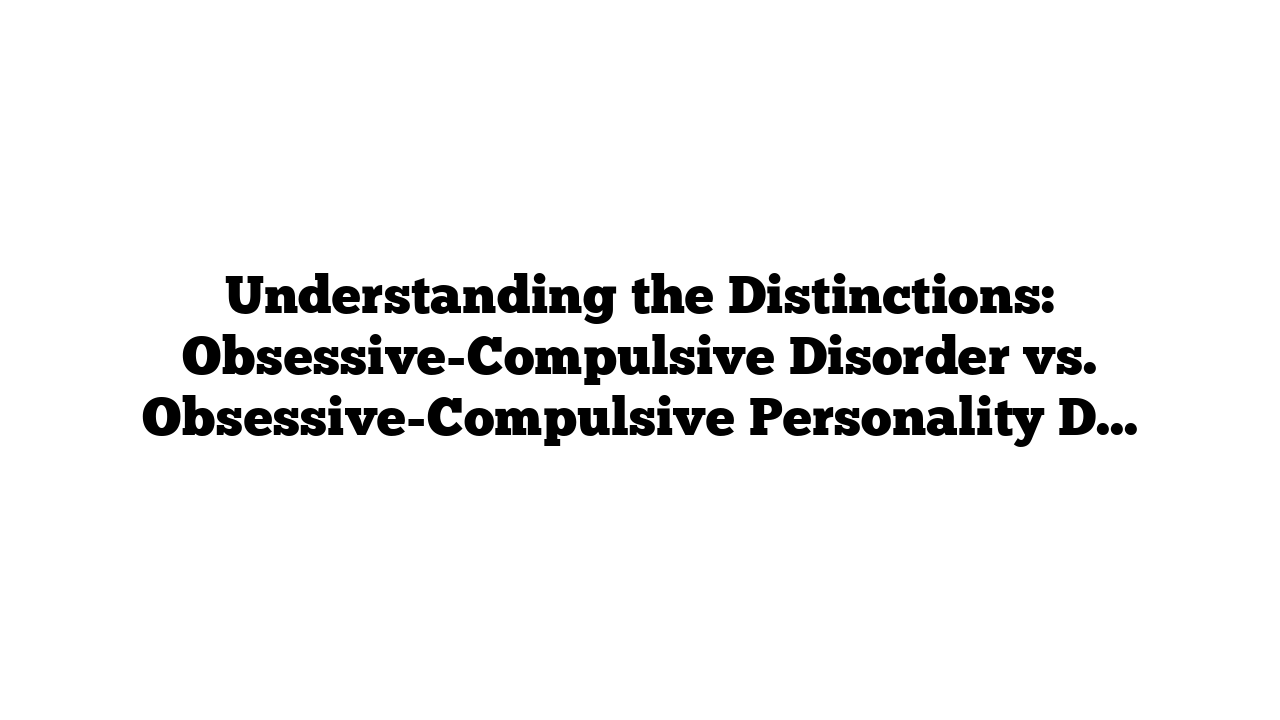Living with mental disorders can be an immensely challenging experience. Individuals often face a wide range of symptoms that make everyday tasks feel overwhelming. This reality is especially true for those grappling with Obsessive-Compulsive Disorder (OCD) or Obsessive-Compulsive Personality Disorder (OCPD). While these terms are frequently used interchangeably in casual conversation, it’s crucial to understand that they represent two distinct conditions.
What Are OCD and OCPD?
Many people mistakenly believe that OCD and OCPD are essentially the same disorder. Although their names are similar, they differ significantly in their characteristics and impact on daily life. Let’s explore each disorder in more detail.
Obsessive-Compulsive Disorder (OCD)
OCD is characterized by two main components: obsessions and compulsions.
- Obsessions are unwanted and intrusive thoughts, images, or urges that repeatedly invade a person’s mind. Despite recognizing these thoughts as irrational, individuals with OCD feel powerless to control them.
- Compulsions are repetitive behaviors or mental acts performed in response to these obsessions. These actions are typically carried out according to rigid rules and aim to alleviate the anxiety caused by the obsessive thoughts. However, the relief they provide is often temporary.
How is OCD Diagnosed?
According to the DSM-5, diagnosing OCD requires meeting four specific criteria:
- Presence of Obsessions and/or Compulsions: The individual experiences intrusive thoughts, images, or urges, as well as repetitive behaviors.
- Time-Consuming: These obsessions or compulsions must take up significant time (more than an hour a day) and severely impact social, occupational, or other important areas of functioning.
- Exclusion of Other Causes: The symptoms must not be attributable to the effects of another substance (e.g., medication or drug abuse) or another mental disorder.
- Not Better Explained by Another Disorder: The disturbance is not more effectively accounted for by symptoms of another mental disorder.
Obsessive-Compulsive Personality Disorder (OCPD)
In contrast, OCPD falls under the category of personality disorders. It is characterized by:
- An excessive preoccupation with orderliness, perfectionism, and control.
- A rigid adherence to rules and schedules, which often results in the inability to delegate tasks or work collaboratively.
- High standards and inflexible rules that can lead to dissatisfaction with oneself and others.
How is OCPD Diagnosed?
To diagnose OCPD, an individual must meet at least four of the following eight criteria:
- Preoccupation with Details: The individual is so focused on the minutiae of a task that they lose sight of its overall purpose.
- Perfectionism: An insistence on doing things perfectly, which can interfere with completing daily activities.
- Excessive Work Dedication: A tendency to prioritize work over leisure or relationships.
- Moral Rigidity: A strict adherence to personal ethics and values that may not allow for flexibility.
- Inability to Dispose of Items: A reluctance to discard items, even those of little or no value.
- Difficulty Delegating Tasks: A refusal to allow others to assist in tasks, resulting in a heavy personal workload.
- Frugality: A general lack of generosity toward self and others.
- Stubbornness: An intense rigidity in thinking and behavior.
Key Differences Between OCD and OCPD
While OCD and OCPD share some superficial similarities, the differences between the two disorders are profound:
- Classification: OCD is classified as an anxiety disorder, while OCPD falls under personality disorders. This distinction influences the nature of the symptoms and the overall experience of individuals living with these conditions.
- Awareness of Thoughts: Individuals with OCD often recognize that their intrusive thoughts are irrational and distressing. This self-awareness can sometimes allow them to mask their compulsions in social situations, even when faced with significant anxiety. Conversely, those with OCPD may lack awareness of their perfectionistic tendencies and believe their rigid standards are justified.
- Nature of Symptoms: OCD symptoms are driven by cyclic intrusive thoughts that create a state of anxiety, leading to compulsions aimed at seeking temporary relief. In contrast, OCPD is characterized by a consistent need for control and perfectionism without the cyclical nature seen in OCD.
- Response to Criticism: Individuals with OCPD may react strongly to perceived criticism, viewing it as a personal attack. This inflexibility can lead to difficulties in personal relationships and workplace dynamics, as their need for control can be oppressive to those around them.
Living with OCD and OCPD
Despite the challenges posed by both OCD and OCPD, individuals can find effective treatments. A combination of medications and psychotherapy can significantly help manage symptoms.
Treatment Options
- Cognitive Behavioral Therapy (CBT): This therapy can help individuals recognize and change negative thought patterns associated with both disorders.
- Exposure and Response Prevention (ERP): Particularly effective for OCD, this therapy involves gradual exposure to feared situations while preventing the compulsive response.
- Medication: Certain medications, like selective serotonin reuptake inhibitors (SSRIs), can alleviate symptoms of both disorders.
If you or a loved one is struggling with OCD or OCPD, it’s essential to seek professional help. For additional resources and guidance, visit medicaltimes.io, where you can find more information and support.
Additional Resources
- Understanding OCD: Symptoms and Treatment
- OCPD: What You Need to Know
- The Role of Therapy in Managing Anxiety Disorders
Recognizing the unique challenges of OCD and OCPD is the first step toward understanding and supporting those affected by these disorders. By fostering awareness and compassion, we can create a more supportive environment for everyone navigating these complex conditions.
